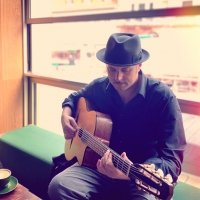DjangoBooks.com
Welcome to our Community!
Categories
- 20K All Categories
- 1.1K General
- 478 Welcome
- 59 Archtop Eddy's Corner
- 146 CD, DVD, and Concert Reviews
- 385 FAQ
- 26 Gypsy Jazz Italia
- 27 Photos
- 203 Gypsy Picking
- 21 Unaccompanied Django
- 15 Pearl Django Play-Along Vol.1
- 17 Gypsy Fire
- 45 Gypsy Rhythm
- 1.4K Gypsy Jazz University - Get Educated
- 131 Gypsy Jazz 101
- 228 Repertoire
- 221 History
- 708 Technique
- 51 Licks and Patterns
- 6 Daniel Givone Manouche Guitare Method Users Group
- 20 Eddie Lang Club
- 1.3K Gypsy Jazz Gear
- 803 Guitars, Strings, Picks, Amps, Pickups and Other Accessories
- 461 Classifieds
- 49 Recording
- 62 Other Instruments
- 18 Violin
- 5 Mandolin
- 22 Accordion
- 7 Bass
- 10 Woodwinds
- 348 Gypsy Jazz Events
- 143 North America
- 110 Europe
- 95 International
In this Discussion
Who's Online (0)
Out of the One, Came Many
For those who haven’t heard this, you might dig it. Barry Harris’ Story of Creation is really cool. Other classical musicians may have talked about this, but I learned it from Barry.
1 chromatic scale (the only 1) divides into 2 whole tone scales (there are only 2). The chromatic scale is god and god created man and women, the 2 whole tone scales. There are 3 diminished chords, each diminished chord has 2 notes from 1 of the whole tone scales and 2 notes from the other whole tone scale. In other words, Man and woman had 3 children, each child had half of its DNA from the mother and the other half from the father. Now we take a diminished chord and do the following:
Say your are playing a D# diminished chord, with your middle finger on the 6th fret A string, ring finger on the 7th fret D string, index finger on the 5th fret G string and pinky on the 7th fret B string.
Let’s meet the extended relatives.
P.S.
As you do this, you may have to adjust your fingering and inversions may vary.
If you lower the middle finger you get D7
If you lower the ring finger you get Ab7
If you lower the index finger you get B7
If you lower the pinky finger you get F7
Do this with the other 2 diminished chords and the is where you get all 12 dominant chords.
If you raise the middle finger you get A min 6
If you raise the ring finger you get D# minor 6
If you raise the index finger you get F# minor 6
If you raise the pinky finger you get C minor 6
Do this with the other 2 diminished chords and the is where you get all 12 minor 6 chords.
If you lower the middle finger and the index finger you get D major 6
If you lower the ring finger and the index finger you get B major 6
If you lower the middle finger and the pinky finger you get F major 6
If you lower the ring finger and the pinky finger you get Ab major 6
Do this with the other 2 diminished chords and this is where you get all 12 major 6 chords.
The next one is interesting.
If you lower the middle finger and the ring finger you get both D7b5 and Ab7b5, they both have the same notes.
If you lower the index finger and the pinky finger you get B7b5 and F7b5, they both have the same notes.
Do this with the other 2 diminished chords and this is where you get all 12 Dom7b5 chords.
If you lower the index finger and raise the pinky you get a B7a#5
If you raise the index finger and lower the pinky you get an F7#5
If you lower the middle finger and raise the raise the ring finger you get a D7#5
If you raise the middle finger and lower the ring finger you get an Ab7#5
Do this with the other 2 diminished chords and you get all 12 Dom7#5 chords.
Cool things with this info.
Barry says every Dominant 7 chord has an important minor, which is the Minor 6 arpeggio built of its 5th. We all do this in gypsy jazz all the time. Take E7, for example. The 5th of E7 is B and you can use a B minor6 arp over E7. D7 would have an A minor6, C7 would have G minor6, ect.
As shown above, Diminished chords each have their own 4 family members of Dom7, min6, maj6, dom7b5 and dom7#5 and, conversely, the family members substitute well with each other, because they share the same diminished parent.
Take Coquette, for example. Instead of playing A7, there are 3 other dominant family members to choose from. (Note: you can use what ever you want over A7, but the 4 family members have the closest tension/release effect with each other, because they come from the same diminished parent). The 3 other siblings are C7 aka “backdoor dominant”, F#7 and D#7. If you take the D#7 and play its important minor, then you get Bb minor 6. Django basically made a living off of this family member. If you play C7 and play its important minor, then you get G minor 6 and THIS! Is where playing a “IV minor 6 over the V7” comes from, which Louis, Charlie and Django used all the time!
I should probably stop typing, but this is my favorite part. If you build a 4 note arpeggio from each chord tone of a Dom7 chord (1, 3, 5, b7) and it’s other 3 family members, then you get 16 different arpeggios to play over a V7. At this point it becomes almost impossible to run out of things to play.













Comments
It's gonna take some time before I can pick up a guitar and follow through this with it. But taking all the notes and dividing them into two piles seems a lot simpler starting point than all the major scales.
Me to! But the short answer is, that any arp can be moved in minor thirds and stay in the same family.
Sort of like moving a diminished 7th chord around by minor thirds? So that if you have (in effect) sort of an "altered diminished 7th chord," and you move it around the same way, it works, even though you get different "colors" for each iteration (as opposed to the exact same notes)?
Right…four major and minor chords in a diminished scale. Knowing it is one thing…hearing each iteration and knowing what it sounds like over the dominant chord is another. Knowing the theory while not simple is not necessarily understanding the sound. If you truly know the sound of each of these then you are probably a pretty advanced player.
edit, one could still be a great player and not understand how each of these iterations sound, it’s great info but not absolutely necessary to sound great. As a composer though it is extremely useful. Still using it scoring is not the same as improving on the spot, again a somewhat different skill set.
www.scoredog.tv
Exactly!
I Agree! With that said, you can do a lot of interesting experimentation. I try to pick from these, my favorite sounds, with the goal in mind of being able to play them as effortlessly as playing the blues - total internalization, while focusing on 100% on improv.
Edit: And then add as I go!!
Oh man, I came back to this by searching the forum for "whole tone". I want to start playing some whole tone phrases as Django used them so beautifully and musically. Then I saw my own comment...and also saw that this was back in '23...damn...well today I took my guitar and went through all these iterations. Most shapes are familiar although I use only a few of them in my playing.
Very unique way of looking at music. You could say a unifying theory.
I'd say for the most dedicated musicians you're talking years of studying to absorb and use all of that in your playing. For most, this is a lifetime of study.
I've been taking small steps recently to apply some of the stuff mentioned in the original post. But the challenge is how to make it musical. As Craig mentioned earlier knowing it is one thing but hearing it while you're playing is a different universe. I faced a situation several times when I hear something cool and very interesting musically (for example from Paulus) so I'll take time to figure it out. At least a few times it turned out to be a straightforward tritone substitution arp. Then I can play it during a solo, more or less verbatim but it just doesn't have the same feel to it. I could just plow through with it but I want to like what I'm hearing when I'm playing. That's when Craig's comment about having to hear it really hits home.
A question; does anyone know of a few songs that make use of a backdoor dominant, bVII7?
Thanks for bringing this back up Buco. Been looking for this. Back to the woodshed!!
Yeah...all these inversions I learned back when I was taking jazz guitar classes in Chicago. But the teacher would stress out "as soon as you learn them, you have to use them in music, voice leading during comping, chord melody stuff...etc...that's why I only really acquired just a very few. You seriously need 10 hours a day to fit it all in.